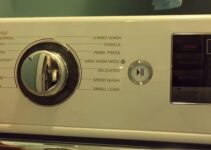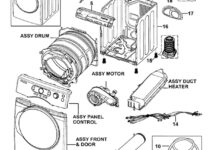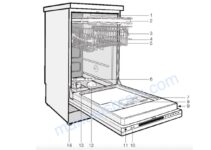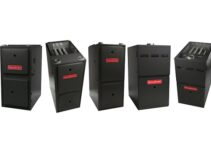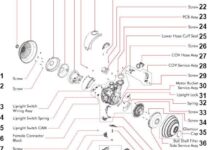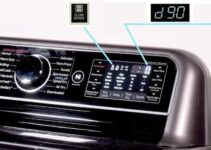The Samsung Ice Maker is an appliance that produces ice for use in drinks and other food items. It is commonly found in refrigerators and freezers, and typically operates by freezing water in a specific compartment and then automatically dispensing the ice into a designated area for use. Some Samsung ice makers also feature automatic cleaning and filtering functions to maintain the quality and taste of the ice.
Samsung Ice Maker Parts Diagram
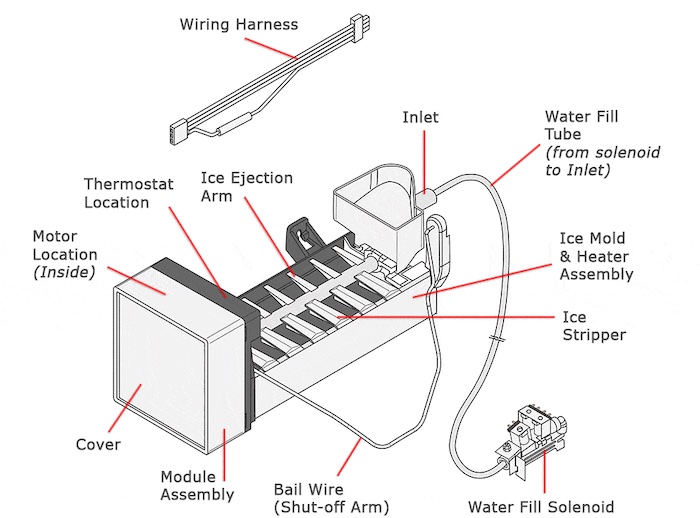
Samsung Ice Maker Parts Explained
Thermostat
The thermostat is a temperature-sensing device that regulates the temperature of the ice maker to ensure that the ice produced is of the correct consistency and texture.
The thermostat monitors the temperature of the ice maker and sends a signal to the ice maker’s heating element or compressor to turn on or off as needed to maintain the desired temperature. This helps to prevent the ice from becoming too hard or too soft, and ensures that the ice maker operates at peak efficiency.
Heater Terminal
The heater terminal is a component that is responsible for heating up the ice tray and ensuring that the ice cubes are released from the tray and into the ice bin. This terminal is typically located on the ice maker unit itself and is connected to the ice tray through a series of wires and electrical components.
Shut-Off Arm
The shut-off arm is a mechanical component that is used to stop the production of ice when the ice bin is full. It is typically located on the outside of the ice maker and is connected to the ice bin through a sensor or lever mechanism. When the ice bin reaches capacity, the shut-off arm will activate and stop the production of ice until the bin is emptied. This prevents overfilling and ensures that the ice maker operates efficiently.
Water Inlet Valve
The water inlet valve is a component that controls the flow of water into the ice maker. It is typically located at the back of the refrigerator and is connected to the water supply line.
When the ice maker is in operation, the water inlet valve opens to allow water to flow into the ice maker and fill the ice tray. When the tray is full, the valve closes to prevent any excess water from entering the ice maker. The water inlet valve is an essential component for the proper functioning of the ice maker.
Saddle Valve
A saddle valve is a type of valve that is used to tap into a water supply line in order to provide water to an appliance or device. In the case of a Samsung ice maker, the saddle valve is used to provide a water supply to the ice maker so that it can produce ice. It is typically installed by piercing the water supply line and attaching the saddle valve to the line using a clamp or other securing mechanism.
Cold Water Pipe
The cold water pipe is a component that connects the ice maker to the water supply in the home. It carries cold water from the supply to the ice maker, where it is used to create ice.
Water Inlet Tube
The water inlet tube is a small tube that connects the ice maker to the water supply. It is responsible for supplying water to the ice maker so that it can create ice. The water inlet tube is typically located behind the ice maker and is connected to the water supply via a valve or other water supply line.
Ice Cube Mold
The Ice Cube Mold is the part of the Samsung ice maker that forms the shape of the ice cubes. It is typically a removable tray or compartment that is filled with water and then frozen to create the ice cubes. The shape of the ice cubes is determined by the shape of the mold, which can vary depending on the model of the ice maker.
Ejector Blades
The ejector blades are the parts that push the ice cubes out of the ice maker tray and into the ice storage bin. They are typically made of a durable, food-safe material and are mounted on a mechanism that allows them to move up and down in order to push the ice cubes out of the tray. The blades are an important part of the ice maker, as they ensure that the ice cubes are consistently and efficiently released from the tray.
Wiring Harness
The wiring harness is a set of wires and connectors that connect the ice maker to the power source and other electrical components in the refrigerator. It helps to provide power and control to the ice maker, allowing it to function properly and efficiently. The wiring harness is an important part of the ice maker and is essential for its proper operation.
Module Assembly
The module assembly on a Samsung ice maker is the main control board and electrical components that control the operation of the ice maker. It includes the ice maker control module, sensors, thermostats, and other electrical components that work together to regulate the ice-making process and ensure that the ice maker functions properly.
Samsung Ice Maker: Common Problems & Fixes
The ice maker is not making ice
- Check if the water supply to the ice maker is turned on and the water valve is fully open.
- Make sure the ice maker is properly connected to the water supply line.
- Clean the ice maker and remove any debris that may be blocking the water supply.
- Check if the ice maker is on and the bin is not full.
- If the ice maker is on but still not making ice, it may be due to a faulty ice maker unit and it may need to be replaced.
The ice maker is making too much ice
- Check the ice maker settings and adjust the ice production rate if needed.
- Make sure the ice bin is not overfilled, as this can cause the ice maker to produce too much ice.
- Clean the ice maker and remove any debris that may be blocking the ice production.
The ice cubes are too small or too large
- Check the water supply line and make sure it is not clogged or frozen.
- Adjust the water pressure to the ice maker, as too low or too high water pressure can affect the size of the ice cubes.
- Clean the ice maker and remove any debris that may be blocking the water supply.
- If the issue persists, the ice maker unit may need to be replaced.
The ice cubes are clumped together
- Check the water supply line and make sure it is not clogged or frozen.
- Adjust the water pressure to the ice maker, as too low or too high water pressure can cause the ice cubes to clump together.
- Clean the ice maker and remove any debris that may be blocking the water supply.
- If the issue persists, the ice maker unit may need to be replaced.
